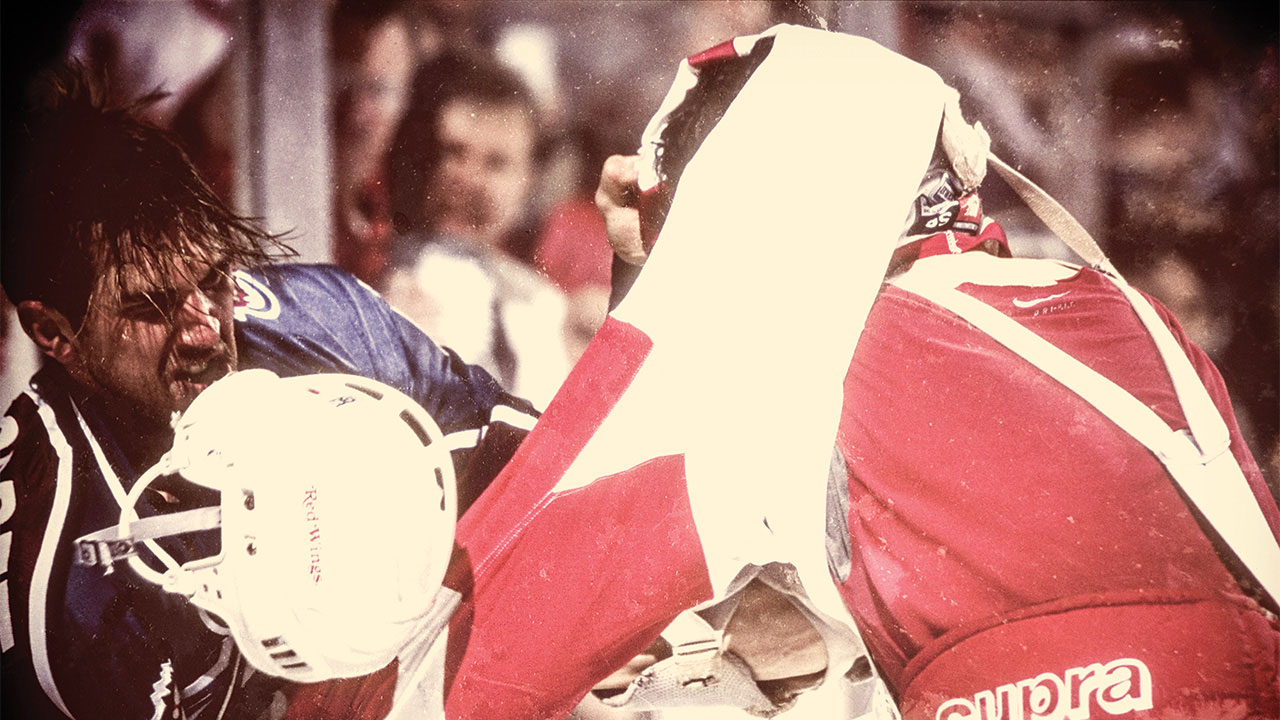As a bookish 16-year-old, a love of hockey was my most—perhaps only—masculine quality. And even that came with a caveat. I loved the Detroit Red Wings; the mid-’90s Red Wings—the smooth-skating, playoff-choking, Russian-employing, non-confrontational Red Wings, who were so often bullied out of the playoffs by tougher teams. Teams like the Colorado Avalanche.
I knew all about being bullied. I’ll spare you all the details, but suffice it to say that one kid, let’s call him “Ryan,” made Grade 11 far from easy for me, with thrown shoulders in the hall, stolen books and jackets, threats of pummellings after school. I didn’t tell my teachers or my parents, because in the mid-’90s that wasn’t done. And I didn’t fight back, because I didn’t really know how.
Whenever the subject of bullying arises today, Ryan’s face and that of Claude Lemieux appear side-by-side in my mind. When Lemieux mashed Kris Draper’s face into the boards in game six of the 1996 Western Conference final, none of Draper’s Red Wings teammates did a damn thing about it. They took it and walked away, just like I always did. Every time I was polite to Ryan in science class, I’d recall what Red Wings winger Dino Ciccarelli said of Lemieux after that game-six loss and the post-game lineups: “I can’t believe I shook his friggin’ hand.”
But really, I was doing the same thing every time I kept my mouth shut. Until March 26, 1997, when the Red Wings taught the Avalanche—and me—an important lesson, in their first game against Colorado with Lemieux on the ice since “the incident.”
A tiny, thoughtful Russian nicknamed “The Professor” started it. Igor Larionov, all of five-foot-nine and 170 lb., decided he’d had enough of being shoved and harassed by Peter Forsberg, the Avalanche sniper who easily had three inches and about 40 lb. on him. The two collided near the boards and Larionov snapped. He reached up, put Forsberg in the best headlock he could apply and wrestled the bigger man to the ice. That opened the floodgates.
Darren McCarty—the closest thing to an enforcer on the Red Wings roster—jumped on Lemieux, who curled into a ball to protect his face as McCarty threw first punches, then knees, at him. Avalanche goalie Patrick Roy stormed from his crease and was hit with a flying tackle by Brendan Shanahan. Wings goalie Mike Vernon—five-foot-nine to Roy’s six-foot-two—skated in and began to brawl with Roy. It was the closest thing I’d seen to frontier justice on ice.
A grinning McCarty affectionately ruffled Larionov’s hair as the two shared time in the penalty box, shouting insults at the flustered Avs in their own sin bin a few feet away. By the end of the game, the refs had handed out 18 fighting majors and 144 minutes in penalties. McCarty scored the winning goal in overtime, of course, with assists from Larionov and Shanahan.
That night marked the birth of the greatest hockey rivalry of the past two decades—a conflict that gave us five playoff series, six Stanley Cup championships, thousands of penalty minutes and several gallons of blood. It also marked the end of my days as a victim—if little Igor Larionov could start a brawl, so could I. So the next time Ryan pushed me, I threw my first real, angry punch. It was nothing like one of McCarty’s, but it got the job done. We were both hauled into the vice-principal’s office, where I managed to talk my way out of a phone call home. The bullying was never mentioned—it was pretty clear from the red mark on Ryan’s face that it was over.
“Sometimes things like that happen when you’re seven years old and you have to wait until you’re 10 to get back at the guy,” McCarty said after that game. “Some guys are still getting even for things that happened when they were kids.”
It’s not that watching that fight turned me into a tough guy. And I’m still not the sort of fan who longs for the brawl-soaked days of the 1970s NHL. But I also don’t scoff when some old-school analyst insists that fighting will always be a part of the game. I hope that it is, because not all fights—in hockey or the schoolyard—are meaningless exercises in violence.
This story originally appeared in the Aug. 26, 2013, issue of Sportsnet magazine.


